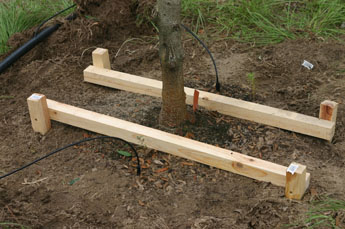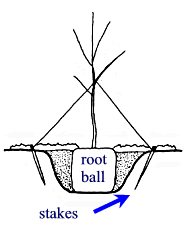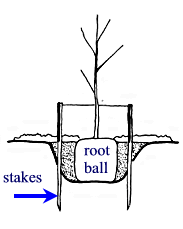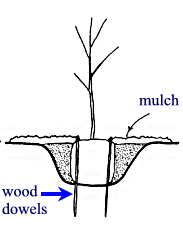Home > Planting trees > Planting details > Tree staking systems
Tree staking systems (see illustrations below)
 A very effective staking system from 2x2s. See: abstract of comparison test. |
Many B&B trees with good root systems do not require stakes to hold them firm in the soil because their root balls are heavy enough to prevent movement in moderately windy weather. Trees may require staking if the wire basket is removed at planting, or if the roots are not firm in the root ball.
Container and bare root trees often require stakes to hold them firm in the soil until roots become established due to the light weight of the root ball. Root balls must remain firm and stable in the soil so the fragile new roots growing into the backfill soil are not broken as the root ball moves in windy weather. Many landscape contractors think staking is good insurance against trees tipping over.
Traditional staking systems are show in Figures 1-3. All three traditional systems require removal within about one year after planting. Figures 4 and 5 show two systems used successfully by urban foresters in moist climates where wood decays rapidly in soil. Both of these inexpensive alternate systems eliminate the requirement to return to the tree to remove the staking system because they simply decay in a few years. The system in Figure 5 holds trees the best of all these sytems we tested in 2006.
Figure 6 shows an alternative, synthetic mulching material useful along streets and highway medians. Tree shelters or plastic tubes can increase survival of very small seedlings, but may have little or no use for standard sized planting stock except perhaps to discourage deer damage. Their use has been associated with retarded trunk diameter growth, damage from birds, mechanical damage from trunks rubbing in the tube, ice and snow loading damage, reduced root systems, and delayed dormancy.
Figure 1: Three short stakes (2 shown) attached to the trunk with rubber or similar stretchable material. Stakes driven straight into the soil (not as shown) hold stakes in soil best. Alternative staking system. |
Figure 2: Three short stakes (2 shown) driven into soil in a traditional manner attached to the trunk with stretchable material. Stakes driven straight into soil are most secure. Use a wide strapping or rubber to secure stakes to trees. |
Figure 3: Two or three (2 shown) 2 x 2 wood stakes driven through the backfill soil into undisturbed landscape soil. These did not work well in our pull tests. Do not use wire in garden hose to secure trees because these can injure or girdle the tree. |
Figure 4: Two or three (2 shown) wood dowels driven through edge of root ball hold 3 gallon trees but not larger trees. These do not have to be removed because they rot in place. There is no danger of this system girdling the trunk since nothing is attached to the trunk. |
Figure 5: One of the best systems we tested. One horizontal 2 in. x 2 in. screwed (dry wall screws decay quickly) to two vertical 4' long 2 x 2s against the side of the root ball. A second set is used on the other side if needed for larger trees. Photo of this system. |
Figure 6: Synthetic mulch, in this case made from rubber, can be used as an organic mulch replacement in areas where organic mulch could blow or float away. |







